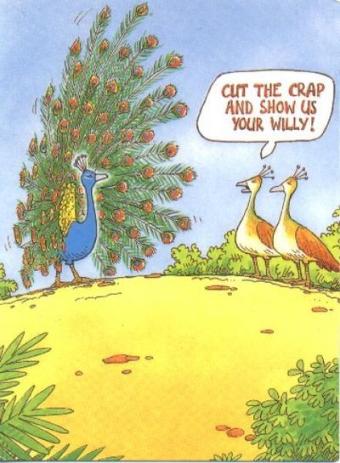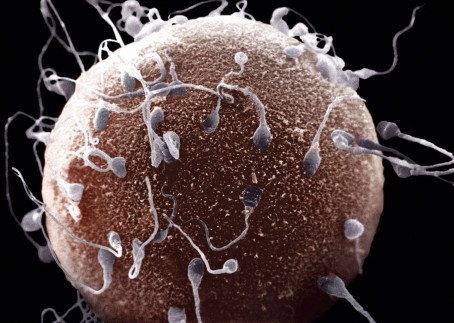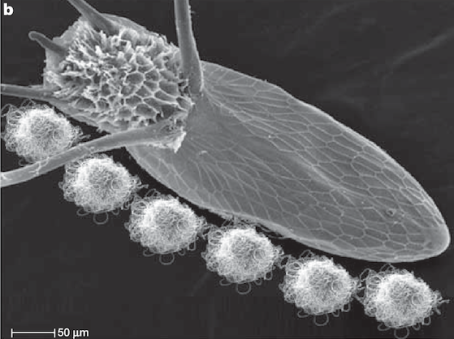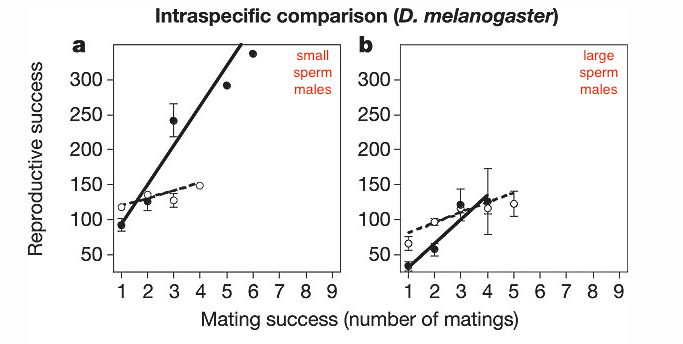In species where anisogamy occurs, the sexes are defined by gamete size. Those individuals with large gametes, called eggs, are defined to be females; while those individuals with small gametes (sperm) are defined to be males. But differences between males and females extend beyond gamete size – there are differences in behavior and appearance too. For example, one sex (typically males) may have beautiful ornaments or fierce armaments that are thought to aid in competition for mates. The other sex may not have these ornaments or armaments (typically females), and instead of competing, they usually choose among potential suitors and provide the bulk of parental care to the young. This process of male competition and female choosiness is known as sexual selection.

Sexual selection: flashy males compete for access to drab females. Perhaps contrary to popular belief, peacocks don’t actually have willies. [Picture credit]

Types of sexual selection and competition within (intra) and between (inter) the sexes. Cryptic female choice happens when females preferentially use the sperm from one male over that of another, for example by dumping the second male’s sperm after copulation.
So why do the sexes differ in traits other than gamete size? These differences, termed sex roles, could arise through a variety of mechanisms that either do or don’t have to do with differences in gamete size.
Mechanisms driving the evolution of sex roles could be completely independent of gamete size. It could be a fluke. Chance alone could cause males to have greater variation in mating success. This would lead males to compete amongst each other for those rare mating opportunities, and result in the evolution of the ornaments and armaments. On the other hand, differences between the sexes when it comes to mating could arise as a byproduct of other sex differences, like differences in mortality, mate encounter rate, or the minimum time required to replenish energy stores between subsequent matings.
However, some scientists argue that all of the above is unlikely to be true. Rather, the differences we see between the sexes always trace back to anisogamy. Why do females have to wait longer before mating again? Because it takes more time to produce a big egg than to produce small sperm. Why do males have higher mortality and beautiful ornaments? Because there are a lot more sperm in the universe than eggs, so males must expend a lot of energy to compete with each other for the attention of females who have those precious eggs.
Environmental variation also plays a role, as well as evolutionary constraints and coevolution between males and females. For example, in some environments mortality for males could be a lot higher than in others, leading to less competition among the remaining males. But – on the whole – the pattern holds: anisogamy is at the root of all the sex differences we observe.
So now that we know that anisogamy has far-reaching consequences, let’s consider how much the degree of anisogamy plays a role. Does it matter whether the egg is 5 or 500 times the size of sperm? Does the degree of sex differences scale directly with the degree of anisogamy?

Classic image depicting anisogamy: a large egg surrounded by tiny sperm. [Picture credit]

Six sperm of Drosophila bifurca (a fruit fly) surround a single egg. The sperm are huge. [Picture credit: Bjork and Pitnick 2006]
Ten years ago, scientists attempted to come to terms with the large sperm paradox in a seminal paper (pun intended). They used fruit flies to confirm that more matings typically lead to more offspring for males, but this does not necessarily hold true for females. When comparing different species of fruit flies, the smaller the difference in gamete size (i.e. weaker anisogamy), the more similar this relationship between mating and offspring number is for the two sexes. In other words, really large sperm are “egg-like” in the sense that they are also energetically expensive to produce.

The relationship between number of matings and number of offspring for males (solid points; solid lines) and females (open circles; dashed lines). [Figure modified from Bjork & Pitnick 2006]
The authors argued that large sperm are indicative that there is strong sperm competition, that’s why index is higher. Sperm size should not be considered a form of parental investment, but rather an ornament or armament. By making his sperm a little bit bigger, a male can give them a competitive edge over this rival’s sperm once they are inside the female. This is the solution to the large sperm paradox! However, we need more studies to get to bottom of this story. In this study, the researchers didn’t control the number of matings that each male had; instead, they just counted how often each male mated in a free-for-all. This could be problematic because it leaves open the possibility that the males who mated more were simply more vigorous and therefore had higher reproductive success regardless of their sperm. By experimentally control how many times each male gets to mate, we could remove this confounding effect.
In any case, it seems that anisogamy matters for sex roles and sexual selection in fruit flies, but in unexpected and nuanced ways!
-Hannes
References
Bjork A, Pitnick S. 2006. Intensity of sexual selection along the anisogamy-isogamy continuum. Nature 441: 149–150. PDF
Schaerer L, Rowe L, Arnqvist G. 2012. Anisogamy, chance and the evolution of sex roles. Trends Ecol. Evol. 27: 260–264. PDF